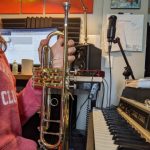WindWorks Trumpet Academy › Forums › WindWorks › Teardrop / Cupid's Bow Lip
Tagged: embouchure, lips, oscillation
- This topic has 2 replies, 2 voices, and was last updated 2 years, 6 months ago by
 john.schreier.jr.
john.schreier.jr.
-
AuthorPosts
-
-
18 January 2022 at 5:38 am #118741
 john.schreier.jrParticipant
john.schreier.jrParticipantWhat are your thoughts on teardrop / cupid’s bow shaped lips for playing trumpet? Specifically – Does it disrupt natural oscillation of the lips in a way that can’t be helped?
I’ve been playing for about 20 years now. As a young trumpet player I developed an embouchure which was offset to the right side of my mouth while being majorly in the red. This helped me achieve a great deal of range for a student but my consistency and endurance was really lacking. For the past few years I’ve transitioned to the center of my lips, and out of the red, to correct those problems. Although my sound, articulation, and consistency have improved, I’ve completely lost my range. At the moment I feel like I’ve hit an impassable plateau. Bb above the staff is now the highest note I feel confident in, which is a major blow to my ego as I was once comfortable up to double G’s. I suspect that this is due to my teardrop upper lip messing up the vibration of my lips in the upper register.
Anyone have experience or good advice on this?
-
18 January 2022 at 10:57 am #118758
johnelwood
ParticipantI’m probably not really qualified to say either way, but I doubt it.
FWIW, I found the following forum on this question on a flute player forum (https://www.reddit.com/r/Flute/comments/kafdcs/cupids_bow_lips/). I realize Flute and Trumpet are different, but there are probably some common responses here.
My gut is that your issue is something more common to what I and many others were battling prior to finding WindWorks and other resources which unlocked are understanding of how the trumpet actually works.
I’ve been playing for the past 3 years or so after a pretty long break (20 years, give or take). I never touched High C and my effective range was a G above the staff, an A on a good day. Endurance was very short.
Back in the 80’s, everything was Tongue Arch… Not how the instrument works…
Shape determines Pitch. Air is for Volume and Long Notes.
Experimentation with Passively released air (but a good full, but relaxed breath) and objectively observing how that effects your sound–including your ability to hit the pitches your after will help you refine Shape and achieve your goals on the horn.
I’m still on this journey myself but continue to get to new milestones. Lately, I switched back to a Bach 3C after playing a 1 1/4C and a Bobby Shew Lead mouthpiece (for different reasons). On my 3C lately, I’ve reached a level of ease above the staff of a whole new level. E above high C is rather easy and I get the G more and more without straining.
The “aperture corners” as Greg refers to contract towards the air column, reducing the aperture, which is what causes the pitch to be higher (my understanding).
The lips aren’t buzzing in a flat/linear plane, the part that vibrates is the inner part that touches the air. Visualizing the air column as a 3 dimensional straw as I’m releasing air through the embouchure helps me at times, as does looking down on the leadpipe as I’m releasing the air.
The WindWorks exercises are very helpful as well. Harmonic slurs–making sure to do them both with quality sound at a slow tempo at first, then focusing on speed, and back and forth helped me a lot.
I believe you’ll get there, FWIW, just takes time and an open mind and focusing on RESONANCE / quality of sound and learning how to refine Shape to improve the quality of the resonance/quality of your sound.
Range comes from effiency, not strength/power IMHO. To play loud up high requires some extra wind support/speed. But less air moves through the horn the higher we play, so very little air is required to play a Double G–it’s just a faster vibration, there’s more compression.
My $.02 FWIW. Good luck!
-
20 January 2022 at 3:29 pm #119046
 john.schreier.jrParticipant
john.schreier.jrParticipantHey johnelwood, thanks for your input. I hear you, I really do, and I’m keeping all of that stuff in mind. I’m staying relaxed, trusting the process, and rewiring my brain.
However, imagine your aperture. Where you might see something resembling a circle or oval, my aperture resembles something more like a bean. There’s an extra flap on the top of the aperture keeping the opening from being a smooth circle. That flap likes to get in the way and interrupt my airflow. I’ve done a lot of experimentation with this on a visualizer but haven’t made much meaningful progress. I’ve been consistently trying to re-train my embouchure for upwards of 3 years now with almost nothing to show for it. I’m beginning to think that my anatomy will always keep me from playing how I want to play. I should have mentioned that I also get an occasional double buzz – especially when I’m playing a mouthpiece with a deeper cup, like a flugelhorn mouthpiece.
Maybe I just need a little dose of plastic surgery haha.
If Greg could weigh in on this, that’d be fantastic.
-
-
-
AuthorPosts
- You must be logged in to reply to this topic.
Recent topics
-
Question of Curiosity – To Teeth or Not To Teeth
by
clawsonk123
1 month, 2 weeks ago -
1.O / 2.0 routine
by
jice.gif
2 months, 3 weeks ago -
Abdominal surgery and time off the trumpet
by
DQ
9 months, 3 weeks ago -
Allegro or Presto Practice Routine
by
djm297
10 months, 2 weeks ago -
Tongue lock – Throat lock
by
Ivo Carrabs
11 months ago
